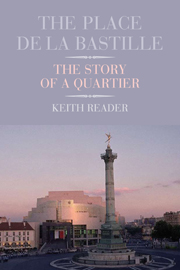Book contents
- Frontmatter
- Contents
- Acknowledgements
- Map by Stephen Ramsay Cartography
- Introduction: The Place de la Bastille
- 1 ‘What's that poor creature doing here?’: the area and the fortress before the Revolution of 1789
- 2 ‘Thought blew the Bastille apart’: the fall of the fortress and the revolutionary years, 1789–1815
- 3 ‘The strategy of the generals of Africa shattered’: the Restoration, Orleanist and Second Republic Years, 1815–1851
- 4 ‘Where is the noise of the storm that I love?’: The Second Empire from Haussmann to the Commune
- 5 ‘Satan's bagpipes’: La Belle Époque's forty-three years of peace
- 6 ‘Villains, stars and everybody in between’: The First War and the entre-deux-guerres
- 7 ‘Slicked hair and splendid sideburns’: Occupation and Liberation
- 8 ‘Let's have some sun!’: post-Gaullism and the Mitterrand years
- 9 ‘A building, not a monument’: the construction of the Bastille Opéra
- 10 ‘A real earthquake’: the impact of the Opéra on the quartier
- 11 Flânerie in the archive: the Faubourg/Bastille today
- Notes
- Bibliography
- Index
Introduction: The Place de la Bastille
- Frontmatter
- Contents
- Acknowledgements
- Map by Stephen Ramsay Cartography
- Introduction: The Place de la Bastille
- 1 ‘What's that poor creature doing here?’: the area and the fortress before the Revolution of 1789
- 2 ‘Thought blew the Bastille apart’: the fall of the fortress and the revolutionary years, 1789–1815
- 3 ‘The strategy of the generals of Africa shattered’: the Restoration, Orleanist and Second Republic Years, 1815–1851
- 4 ‘Where is the noise of the storm that I love?’: The Second Empire from Haussmann to the Commune
- 5 ‘Satan's bagpipes’: La Belle Époque's forty-three years of peace
- 6 ‘Villains, stars and everybody in between’: The First War and the entre-deux-guerres
- 7 ‘Slicked hair and splendid sideburns’: Occupation and Liberation
- 8 ‘Let's have some sun!’: post-Gaullism and the Mitterrand years
- 9 ‘A building, not a monument’: the construction of the Bastille Opéra
- 10 ‘A real earthquake’: the impact of the Opéra on the quartier
- 11 Flânerie in the archive: the Faubourg/Bastille today
- Notes
- Bibliography
- Index
Summary
Among the many Parisian squares which may form part of the visitor's itinerary, the Place de la Bastille is among the least inviting – a whirligig of fairly characterless late nineteenth-century buildings, with on one side the glassy modernity of the controversial 1989 opera house. At its centre stands the 1840 Colonne de Juillet, erected in homage to those killed in the 1830 July Revolution, many of whom are buried in its base. Lacking the monumental elegance of (in very different ways) the nearby Place des Vosges or the Place de la Concorde, or the imposing perspective down the Champs-Élysées afforded by the Place de l'Étoile (officially now known as the Place Charles de Gaulle), the Place de la Bastille is primarily seen as an interchange, the nexus of three Métro lines and a number of bus routes.
Why, then, choose this quartier for a detailed cultural and historical survey? Other areas have more evident appeal – artistically (Montparnasse), intellectually (Saint-Germain-des-Prés and the Latin Quarter), hedonistically (Montmartre) or architecturally (the Champs-Élysées). The adjacent Marais – successively a popular Jewish quartier, the showpiece of the renovation of Paris undertaken in the 1960s under André Malraux and the major gay area of the capital – would generally be thought to possess greater ethnocentric interest. Bastille, unlike the areas just mentioned, would not figure on most tourists' lists of quartiers to be visited.
- Type
- Chapter
- Information
- The Place de la BastilleThe Story of a Quartier, pp. 1 - 19Publisher: Liverpool University PressPrint publication year: 2011



